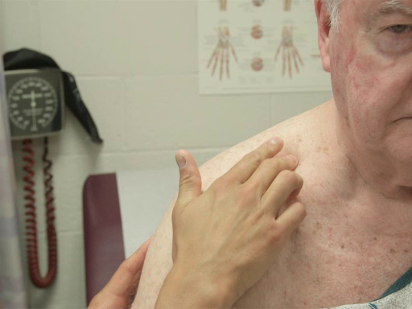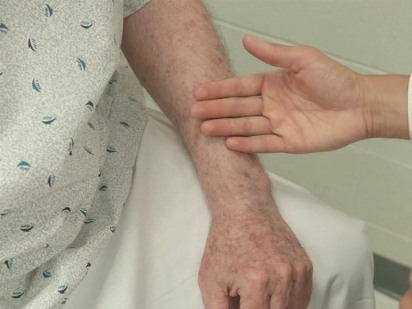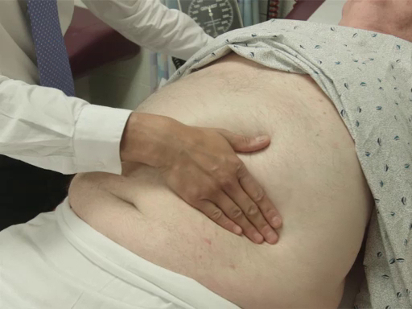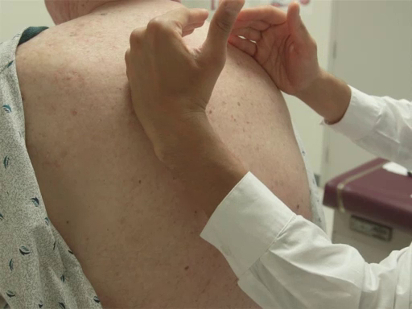촉진
English
Share
Overview
출처: 자이딥 S. 탈와르,MD, 내과 및 소아과, 예일 의과 대학, 뉴 헤이븐, CT
신체 검사는 환자에 대한 정보를 얻기 위해 공급자의 모든 감각을 사용해야합니다. 촉감은 심포메이션을 통해 진단 정보를 얻기 위해 활용된다.
심PAtion에 사용되는 심사관의 손의 특정 부분은 검사중인 신체 부위에 따라 다릅니다. 그들의 조밀한 감각 적 내분 때문에, 손가락 패드는 미세 차별(예를 들어,질량, 림프절의 테두리를 정의)(도 1)에유용합니다. 손의 등쪽 표면은 상대 온도의 거친 감각을 제공합니다(도 2). 손가락과 손의 팔마 표면은 신체의 넓은 영역(예를 들어,복부)을 측량하는 데 가장 유용합니다 (예 : 복부)(그림3). 진동은 손의 척골 표면과 5번째 손가락(예 :촉각 프레스미상)(도4)으로가장 잘 평가됩니다.
심피는 신체 검사의 진단 측면에 근본적이지만, 환자 만남 중에 터치가 배려와 편안함을 전달하는 역할을 인정하는 것도 중요합니다. 환자는 일반적으로 긍정적인 빛에 있는 헬스케어 공급자에게서 접촉을 인식하고, 헬스케어 공급자의 그들의 인식은 임상 만남 도중 터치의 숙련된 사용에 의해 형성될 수 있습니다. 1 물리적 접촉 호르몬과 신경 전달 물질 수준에 변경과 관련 된, 특히 코 티 솔감소 하 고 세로토닌증가. 2
따라서, 심플의 주의 깊은 사용을 통해, 일반적으로 터치, 신체 검사 하는 동안, 임상의는 중요 한 진단 정보를 얻을 수 있는 기회를 가지고, 교감을 개발 하 고 치유를 촉진 하는 동안.

그림 1. 손가락 패드림프절 검사.

그림 2. 손의 dorsum을 사용하여 따뜻함을 평가합니다.

그림 3. 손가락과 손의 팔마 표면과 복부 심근.

그림 4. 손의 척골 표면을 사용하여 촉각 프레스미동을 평가합니다.
Procedure
Applications and Summary
This demonstration covered the general considerations related to palpation during the physical examination. While specific techniques vary based on each individual portion of the exam, many general principles related to palpation hold throughout the exam. Attention to patient safety and comfort is achieved through hand-washing, proper grooming, warming of the hands, infection control precautions, and sensitive draping. The correct part of the fingers and hands should be used for different types of palpation, with finger pads being used most commonly during the exam. The clinician should be deliberate about the amount and duration of pressure being applied during palpation; these variables change based on the part of the body being examined and specific patient circumstances. Finally, the clinician should remember the important role that touch plays in the patient encounter in terms of therapeutic value and the clinician-patient relationship. The most direct physical contact during the encounter occurs through palpation, which provides an opportunity to secure the bond the clinician has started to develop during history taking.
References
- McCann, K., McKenna, H.P. An examination of touch between nurses and elderly patients in a continuing care setting in Northern Ireland. Journal of Advanced Nursing. 18, 838-46 (1993).
- Field, T. Violence and touch deprivation in adolescents. Adolescence. 37 (148), 735-749 (2002).
- Verrees, M. Touch me. JAMA. 276 (16), 1285-1286 (1996).
Transcript
During a physical exam, the clinician uses the sense of touch through palpation to obtain useful diagnostic information. It is an assessment technique in which the examiner uses the surface of the fingers and hands to feel and examine an organ or body part. While palpation is fundamental to the diagnostic aspect of the physical exam, it is also important to acknowledge the role that touch plays in communicating caring and comfort during the patient encounter.
This video will illustrate the different palpation techniques, and discuss the approach and considerations for this procedure.
First, let’s discuss the different types of palpation techniques that are based on the specific parts of the examiner’s hand used to perform the procedure. Finger pads are used for palpation of most of the body parts. Because of their dense sensory innervation, the finger pads are useful for fine discrimination, for example defining the borders of masses, or while examining the lymph nodes. Fingertips are used for palpating specific structures like the nailbeds, liver edge, and cervix. In addition to fingertips and finger pads, physicians also use the ulnar surface of the hands and fifth fingers to appreciate vibration when performing specialized test like tactile fremitus. One should use the palmar surface of the fingers and hands for assessing functions like chest expansion, palpation of the precordium, light and deep abdominal palpation, and muscle strength testing. Lastly, the dorsal surface of the hands is used for getting rough sense of relative temperature, typically in comparison to another portion of the patient’s body.
Now that you know about different palpation techniques, let’s discuss the general approach to palpation during any clinical exam.
Before every patient encounter, make sure that your fingernails are clean, groomed, and trimmed. Wash your hands with soap and water or apply topical disinfectant solution. Warm your hands either with warm water or by rubbing them together. If any specific infection control precautions are needed, then wear the protective equipment and explain to the patient why it’s necessary. Remember: gowns, gloves, and masks can present a barrier to building a relationship with the patient.
In order to gauge the patient’s comfort with the clinician’s touch, you may start the examination with the hands. First, perform palpation of the nailbeds with your fingertips to assess for capillary refill and pallor. Then, palpate the radial pulse with your finger pads. After that, move to the anatomic region of interest, in this case the abdominal region. Employ draping techniques to optimize access, while balancing patient’s modesty. Next, ask the patient to point to the area of discomfort. Consider palpating it towards the end, making it clear to patients this is done in the interest of their comfort, “I’m going to examine this area last in order just to make it more comfortable for you.”
In general, be aware of the pressure used for palpation, which varies based on the structures being examined. For example, insufficient pressure may limit one’s ability to palpate deep structures, and excessive pressure may occlude a pulse, causing discomfort and limiting utility. Be deliberate about the palpation duration as well, which again differs based on the structure under examination. For example, while examining the lower extremities, the palpation needs to be performed for sufficient amount of time to reveal pitting edema, if present. This kind of information can be missed if palpation duration is insufficient. In addition, express empathy while acknowledging that examination of certain parts may cause the patient discomfort. Although patient expects to be examined, always ask permission and provide a warning if you are about to do something that may worsen the pain. At the end of the exam, drape the patient back and thank them for their cooperation.
You’ve just watched JoVE’s introduction to palpation. This demonstration covered the types and general considerations related to palpation during a physical exam. Through the careful use of this technique, the clinician has the opportunity to gain important diagnostic information, while developing rapport and promoting healing. As always, thanks for watching!
